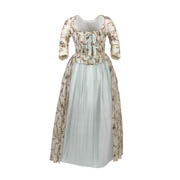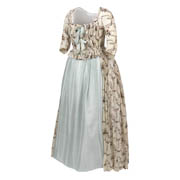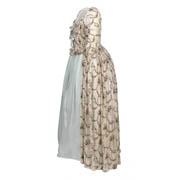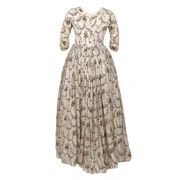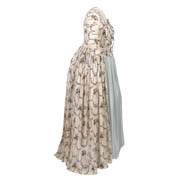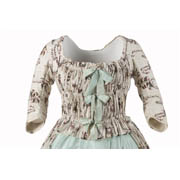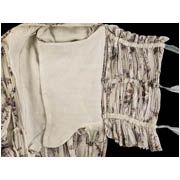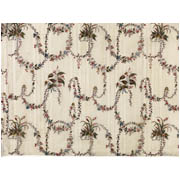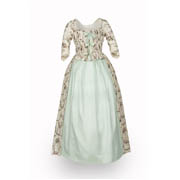Details
- Object type
dress; gown; robe
- Place Associated
Scotland (place of use)
- Date
circa 1785-1790
- Materials
cotton, linen, hand-stitched
- Description
-
Woman's dress, English gown, robe à l'Anglaise retroussé in white cotton muslin (approximately 63 threads per cm warp and 53 threads per cm weft) woven with warp-faced narrow white self-stripes (repeat 2 inches across with intervals of 2 inches) and wood block-printed and painted with small floral sprays and interlacing narrow swags with black outlines, blue (probably indigo), green (overprinted yellow on blue), purple, red (probably madder) and yellow (possibly weld or quercitron bark) (block repeat 10 x 7.5 inches).
Closed bodice with square-cut decolletage, cut with two front bodice panels horizontally ruched with three drawstrings of light blue-green ribbons (some replaced at later date) that fasten centre front with bows, and four panels at back with deep v-shape at centre back waist. Elbow length sleeves. Skirt open at front, pleated into waist of bodice with extra fullness at back. Internal sets of three tapes (one missing) and loops to tie the skirt up. Bodice lined in linen with front panels unattached to printed muslin, bone at centre back.
This is beautiful gown has an unusual construction of bodice with the two front panels horizontally ruched by pulling three drawstrings to fasten with light green ribbons. It reflects the transition from the robe a l’Anglaise to the round gowns with their raised waistlines that occurred in the late 1700s.
The gown is made from a fine muslin, which was in great demand during the late 1770s onwards. Originally they were imported from India, but textile manufacturers in Manchester and Paisley were soon producing similar goods. Mrs Delany wrote in 1778 that 'I have been at a great loss to get you a few yards of the Indian dimity. … Manchester has bought that manufacture to so great a perfection, that it is difficult to know which is right. However, I cut the matter short by sending you four yards, ell-wide, that I had by me, of finer than I can meet with, and I am sure it is Indian, tho' not as which as Manchester, but will wash a very good colour'. The absence of three blue threads in the selvedge that were woven into British cottons from 1776 suggests that the muslin for this gown may have been made for India but using a design drawn for the British market.
Worn by Katharine Wedderburn or her younger sister, Isobel Wedderburn.
- Credit Line/Donor
Gifted by Ernest Maclagan Wedderburn, 1940
- ID Number
E.1940.47.c
- Location
In storage
- Related People
Isobel Wedderburn wearer (possibly)
Katharine Wedderburn wearer (possibly)

